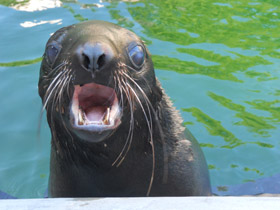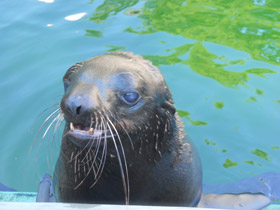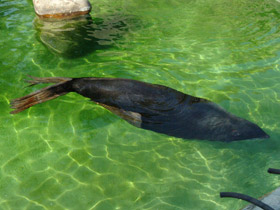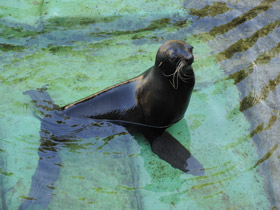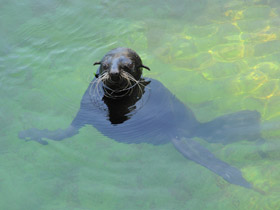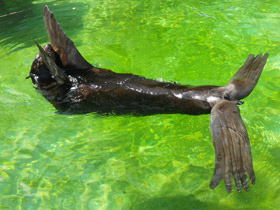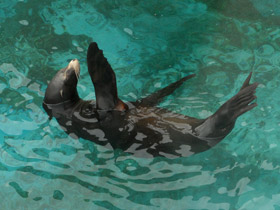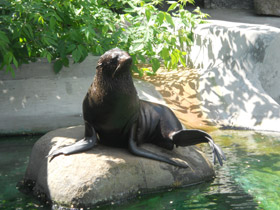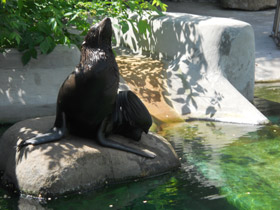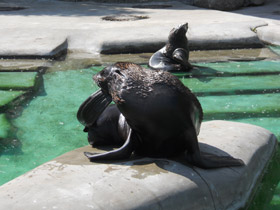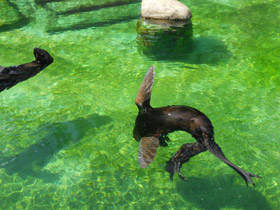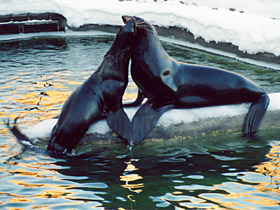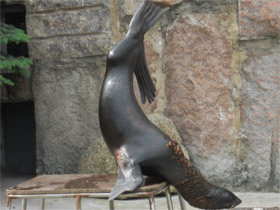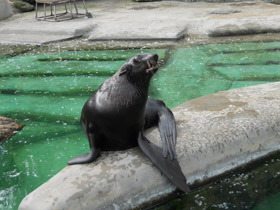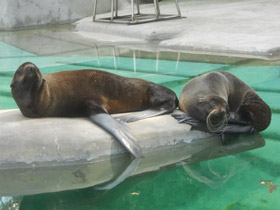The northern fur seal (Callorhinus ursinus)
The northern fur seal (Callorhinus ursinus) is an eared seal found along the north Pacific Ocean, the Bering Sea, and the Sea of Okhotsk. It is the largest member of the fur seal subfamily (Arctocephalinae) and the only living species in the genus Callorhinus. A single fossil species, Callorhinus gilmorei, is known from the Pliocene of Japan and western North America.
Description and special features
Callorhinus ursinus is a species of pinniped mammal of the Othariidae family, the only one of the genus Callorhinus.
Callorhinus ursinus are excellent underwater hunters. In their natural habitat they are unusually agile and graceful and swim through the zoo pool at such speed that they are often mistaken for fish or dolphins (photo 2).
During most of the cold season, Callorhinus ursinus swim away from the coast in the Pacific Ocean and remain offshore for about seven months.
Their excellent eyesight and special eye structure allow them to see their prey underwater at great distances, even in semi-darkness. The eyes of Callorhinus ursinus are very large, dark brown, protected by a thick corneal film that shields them from corrosive seawater (photo 1 and 1-a).
The viburon's sensitive whiskers detect the slightest vibrations emanating from a passing fish, and excellent hearing helps it to hear any splashes in the water (photo 3, 4). Once it has determined the location of prey, Callorhinus ursinus swims quickly and grabs it with its toothed mouth, feeding on various types of fish, squid and cuttlefish.
A distinctive feature of Callorhinus ursinus (like all long-eared seals) is the small but very visible external cartilaginous ear flaps (see photo 4). When SEALs dive, their lateral edges close tightly, preventing water from entering.
The front flippers of the swimming Callorhinus ursinus resemble the wings of a bird: it appears to fly in the water by flapping them, the rear flippers act as rudders and balancers. At the ends of each of the four toes of the hind flippers are claws that Callorhinus ursinus needs for brushing and combing the hair (photo 13).
The body of Callorhinus ursinus is very flexible and the flippers are more agile than those of harbour seals and are used for support when moving on land. For example, Callorhinus ursinus can easily bend and scratch with its hind flippers (photo 5, 6, 9, 10). In the wild, these pinnipeds manage to get out of the water on slippery and almost steep rocks. In captivity, they are very trainable and exhibit miracles of trainability. Without much compulsion Callorhinus ursinus learns to walk and stand on its front flippers (photo 12).
Reproduction
To reproduce, all Callorhinus ursinus and sea lions gather in numerous herds, called colonies; here they give birth and raise their young, and then, at the end of the breeding season, head back out to sea.
Males strive to gather as many females as possible in their territory, engaging in fights with competitors and sometimes forcing females into their harem. In doing so, females can be seriously injured. Northern Callorhinus ursinus has the largest harems, with up to 50 females.
Ecology
Fur seals feed opportunistically, mainly on pelagic fish and squid, depending on local availability. Identified prey include hake, herring, lanternfish, capelin, pollock and mackerel. Their feeding behaviour is mainly solitary.
Sharks and killer whales are the main prey of fur seals. Occasionally, very young animals are eaten by Steller sea lions. Occasional predation of live pups by Arctic foxes has also been observed.
Due to the high density of pups in breeding colonies and the young age at which mothers begin foraging trips, mortality can be relatively high. Consequently, the carcasses of the young are important for enriching the diet of many scavengers, in particular gulls and arctic foxes.
In 2017, 14 samples of spiny lice were collected from the nasal passages of fur seal pups. In 2021, these spiny lice were identified as having a unique bristle arrangement and were given the scientific name Antarctophthirus nevelskoyi. They are named after the famous Russian explorer, Admiral Gennady Ivanovich Nevelsky.

















